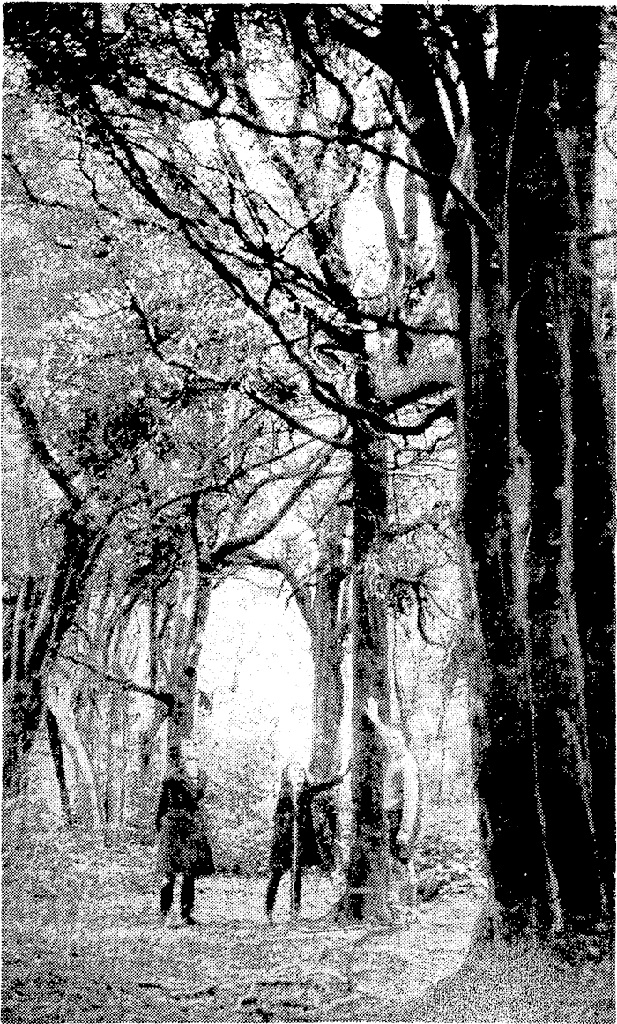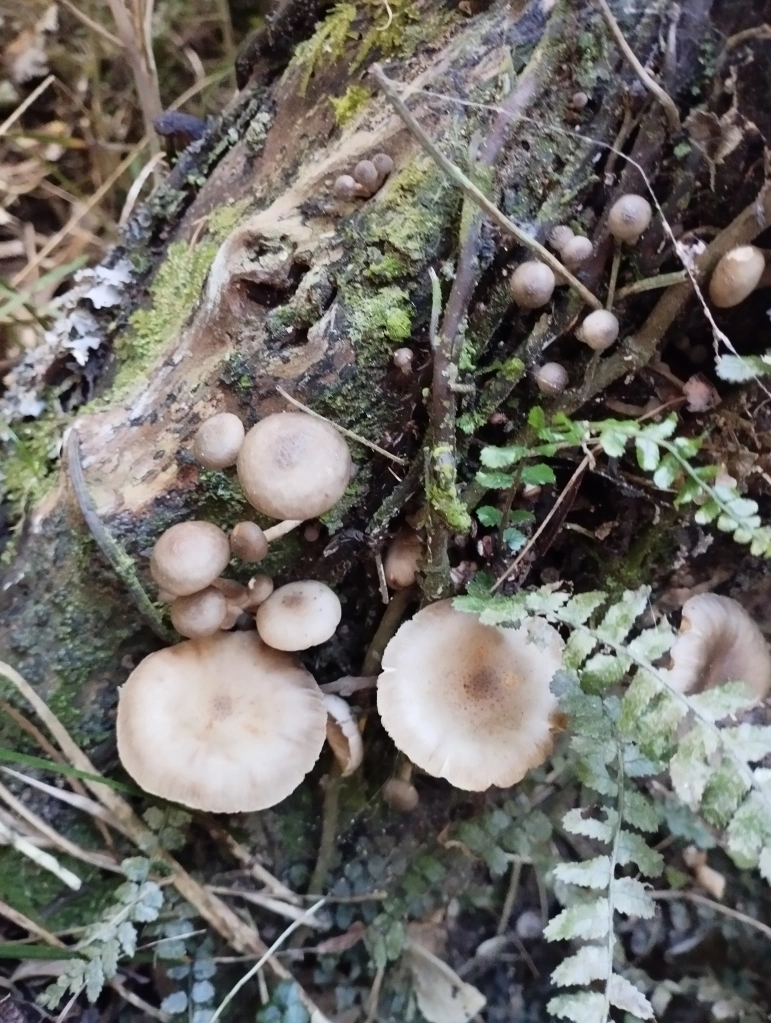In 1942 the Wellington Botanical Society visited the newly established Johnston Hill Reserve in the Wellington suburb of Karori (WCC, 2024). This was a 66 acres (approximately 27ha) bush block bought for ₤2500 and described in 1939 as:
“Except for the absence of the giant matai, rimu, and totara, which were cut out to provide building material for Wellington’s earliest homes, the forest on Johnston’s Hill is a typical New Zealand one and is unexcelled anywhere in the Dominion. Towering 80 feet above the floor of the bush, the lofty rewa rewa is the tallest of the trees that clothe the hillside, but it is run close by many other varieties, and the average height of the forest, though from afar it may not seem so, is 35 to 40 feet. There is a fine stand of kohe kohe, the New Zealand mahogany free, which is not usually found in such numbers as it is on Johnston’s Hill, and another unusual attraction is a double-headed punga fern of almost perfect symmetry. Native shrubs and ferns flourish in profusion, providing cover for the larger trees, which are making noticeable progress.” (Anon., 1939a)

The Society’s foray to Johnston Hill reserve was recorded by Joy EM. Osborn in article published in their 1943 newsletter as “Bush Fungi”:
“One Saturday in 1942 the Society spent an afternoon in the new reserve on the slopes of Mt Johnson [sic], Karori. Stormy weather had made the path slippery, but it was a fine warm day for the trip. Such conditions, warmth following rain, are ideal for the growth of certain of a group of certain [of a] of plants which includes not only some of the most destructive, but also some of the most interesting, useful, and beautiful members of the plant kingdom – namely, the fungi or mushroom family.
“The conspicuous, colourful parts of the plant which we see growing in the bush, or on stale cheese, or in the shops at 5/6 per pound, are the fruiting bodies which produce the millions of tiny spores by which the fungi spread. The plant itself is only a tangle, of the -finest threads which penetrate deeply into whatever substance the particular fungus chooses for its food.
“Some of the fungi are edible, others are used in the making of food, e.g. bread. Yet others cause dreadful destruction of crops, e.g. potato blight and wheat rust, and some cause disease in man, e.g. ringworm. But those we saw that Saturday grow always in the bush, and though their action is destructive, their presence is necessary and useful in the cycle of forest life. It is only when destructive fungi attack young trees or destroy or disfigure valuable timber that they become an economic menace.
“No living thing exists in the same state for ever, and much as we admire the stately forest trees which dominate the bush, we know that while their shade is cast saplings below struggle and do not reach maturity. Therefore it is a useful purpose served by the fungus which invades the wood of an overmature tree, and gradually causes it to fall, allowing healthy young trees to take its place. Such fungi gradually break down the wood of the great trunk, and so undermine its strength that a time comes when it falls with a strong gust of wind, or when its branches are weighed down with snow or rain. The work of this type of fungus may be only just beginning when the tree is dead. It continues to spread, and many other fungi, some of which can grow only in dead trees, now attack. Tiny spores lodge in a wound or crack in the bark, and if sufficient moisture is present-they spread threads deep into the wood where complex chemical changes take place; gradually, with the help of insects and bacteria, the whole tree crumbles back into rich humus to serve as food for its successors.
“During our expedition a number of fructifications of different kinds of forest fungi were noticed and collected. Among the wood-destroyers on the trunks of dead or dying trees were the bracket-shaped hard shelves of Fomes applantus [Ganoderma sp.], black and furrowed on top and white on the spore-bearing, flat under-surface. These, unlike the fruit of most fungi (which grow and die quickly) are perennial and grow larger and shed millions more spores from year to year. Others in this category were the golden-crown Fomes robustus [Fomitiporia robusta], and several species of colourful Porias [sic], which are perennial, but spread over the surface of wood instead of forming brackets. These may prove to be resupinate forms of the shelf-type. All these belong to the Polyporaceae characterised by pits or pores on the lower surface, from which the spores escape.
“Many other wood-destroyers are not “pored”, e.g. spores are formed on a smooth under-surface in species of Stereum which spread over the bark, though with a tendency to form thin leathery shelves. Others are spined or gilled, e.g. Hydnum and Armillaria respectively.
“There are many more fungi in our bush than those few that rot the wood of over-mature or dead trees. Some have little brightly coloured cups and heads, or large vivid “toadstools”; others have blackish inconspicuous fruits. They live on decayed leaves and debris or in the bark, and their fructifications appear under warm moist conditions, especially in autumn. Their beauty is transient. They shed their spores and then die or are eaten by insects, but their presence in our bush makes its study more varied and our expeditions more interesting, besides supplying evidence of one aspect on succession in the life of the forest.”
Fung seen at Johnston Hill, 26 April 2024:
Armillaria novae-zelandiae https://inaturalist.nz/observations/209413842
Auricularia cornea https://inaturalist.nz/observations/209416005
Corticium sp. https://inaturalist.nz/observations/209406997
Cyclocybe parasitica https://inaturalist.nz/observations/209415408
Entoloma sp. https://inaturalist.nz/observations/209414722
Favolaschia claudopus https://inaturalist.nz/observations/209408857
Ganoderma sp. https://inaturalist.nz/observations/209408600
Hohenbuehelia sp. https://inaturalist.nz/observations/209416471
Oudemansiella australis https://inaturalist.nz/observations/209413201
Reference
Anon. (1939a) Johnston’s Hill native forest: Chance of acquisition for city reserve. Evening Post, Volume CXXVII, Issue 82, 8 April 1939, Page 5. https://paperspast.natlib.govt.nz/newspapers/EP19390408.2.13
Anon. (1939b) A picturesque scene … Evening Post, Volume CXXVII, Issue 102, 3 May 1939, Page 9. https://paperspast.natlib.govt.nz/newspapers/EP19390503.2.48.5
Osborn Joy E.M. (1943) Bush Fungi. Wellington Botanical Society Bulletin 6: 11-12. https://bts.nzpcn.org.nz/site/assets/files/21711/well_1943_6__11-12.pdf
WCC (2024) Outer Green Belt Reserves: Johnston Hill. Wellington City Council https://wellington.govt.nz/recreation/outdoors/parks-and-reserves/outer-green-belt-reserves/johnston-hill Viewed 25 April 2024.
![Johnston Hill Reserve, Wellington 26 April 2024 [photo Geoff Ridley]](https://sporesmouldsandfungi.files.wordpress.com/2024/05/img_20240426_131652.jpg)

![Corticium (Porias) [photo Geoff Ridley]](https://sporesmouldsandfungi.files.wordpress.com/2024/05/img_20240426_131755.jpg?w=771)
